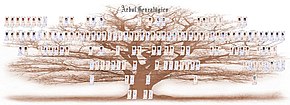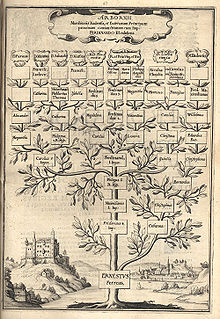Family tree
![]()
This article is about tree representation - for other meanings, see Family tree (disambiguation).
![]()
The whole article is not sufficiently supported by evidence (for example, itemized). Information without sufficient evidence may be removed soon. Please help Wikipedia by researching the information and adding good evidence.
→ The definition needs evidence. Also missing is "Historical development" of the pedigree concept. --Chiananda (discussion) 16:24, 22 Nov 2013 (CET) + 02:54, 29 Jun 2019 (CEST)
A family tree (modern loan transfer from Middle Latin arbor consanguinitatis "tree of consanguinity") is in the general sense the tree-shaped representation of the descent of living beings, things or ideas from each other, starting from one or two underlying specimens at the tree root. In genealogy, a family tree is the representation of the descendants of a (former) person or couple known by name; the person or couple is shown at the bottom with connecting lines branching upward to their "descendants" and their descendants.
Colloquially, a family tree is also erroneously understood to be the representation of a family line or family list in the form of a tree trunk ("family tree"), in which only the succession in the paternal line to the respective eldest legitimate son over several generations is depicted. Thus this representation contains however only a very small section of the descendants of the original progenitors, because all ancestors of the respective mothers as well as the brothers and sisters of the hereditary sons and their descendants remain unconsidered, the representation lacks the ramifications in lateral lines. Even GenWiki, which is well known in genealogical circles, defines pedigree as such a male line. A historical model for this form of representation is the Jesse tree (root Jesse), a common pictorial motif in Christian art, especially in the Middle Ages, which is supposed to depict a family tree of Jesus Christ (see also Tree of Life in the history of religion).
The opposite of a family tree, i.e. the representation of a person's ancestors, is correctly called an Ahnentafel (or ancestry chart). The Duden also incorrectly describes the meaning of family tree as "proof of as many ancestors as possible" and equates it with a "descent table" (Ahnentafel). Also wrong in this understanding is the change from descendants to ancestors and how "as many ancestors as possible" should be represented in the form of a tree tapering downwards.
Other forms of representation of kinship relations are the descendant table or the descendant list, where the source person is at the top or on the left. Genealogically, we only speak of a family tree if the graphical representation is in tree form (see also the tree concept in graph theory). Family trees are also created for animal or plant individuals, in a figurative sense also for objects and ideas (see below).
A combination of ancestor and descendant charts is the kinship chart used in genealogy, where the parents and other ancestors and children and other descendants of a person or couple are shown. From the shape of the representation, this is also called an hourglass representation.
A complex, comprehensive representation of the relationship of a person or family is the genogram.

Schematic structure of a family tree

A family tree, created with the software Ahnenblatt

Family tree from the Arboretvm genealogicvm of 1635 with the attempt to trace back almost all European ruling dynasties to the descendants of Rudolf of Habsburg
History
In antiquity such representations were ornamentally and figuratively richly decorated, going back to the biblical passage of the root of Jesse (Is. 11,1).
In the early Middle Ages, highborns represented their uniqueness and sacredness of their kinship ties (bloodline). From the High Middle Ages until the beginning of modern times, proof of being of noble blood (having a certain number of freeborn ancestors) became important in order to obtain the right to knighthood and tournament participation, in a broader sense also the right to enter a knightly order or a noble cathedral or collegiate chapter. This form of representation - often decorated with heraldic representations - is called a swearing-in tablet. Kinship relations were important in marriage and inheritance law at that time. The striving for prominent, legendary ancestors as far back as possible occasionally led to abstruse claims of descent.
Terms and forms of representation
Kinship and descent can be described in various forms. Besides the graphical representation in tree form, list representations are also common, which are more space-saving:
| Designation | Graphic | List |
| all descendants | Family tree, descendant table | Descendants list |
| all ancestors | Pedigree | Genealogy |
| ancestors and descendants of a person | Table of relatives | Lists of relatives |
| zombie | Main line | Master list |
Search within the encyclopedia